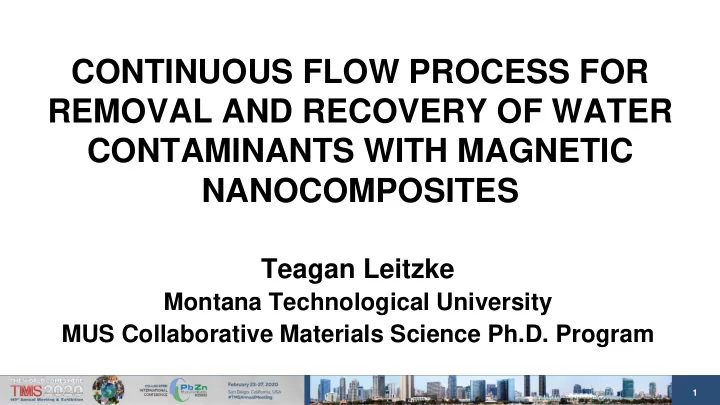

CONTINUOUS FLOW PROCESS FOR REMOVAL AND RECOVERY OF WATER CONTAMINANTS WITH MAGNETIC NANOCOMPOSITES Teagan Leitzke Montana Technological University MUS Collaborative Materials Science Ph.D. Program 1
Overview • Introduction • Experimental Methods – Nanoparticle Synthesis – Reactor Testing • Results to Date • Initial Conclusions • Path Forward • Acknowledgements • References 2
Magnetite Introduction • Magnetite Nanoparticles (Fe 3 O 4 NPs) Source: National Center for Biotechnology Information. PubChem Database. – Natural PAA acetal functionalization – Synthesized • Si-coated • Chitosan coated • Metal Recovery System Chitosan – Continuous flow – Nanoparticle capture Source: Zargar et al. (2015) 3
Introduction • Research Objectives – Modify reactor technology – Optimize synthesis – Maximize heavy metal adsorption – Minimize/Eliminate environmental concerns 4
Nanoparticle Synthesis Three Steps: d 1. Silica coating 2. MTMS/CPTMS Functionalization 3. PAA Functionalization a b c 5
SEM Images of Fe 3 O 4 Nanoparticles 20 µm 100 µm Left: Natural Fe 3 O 4 from SkySpring Nanomaterials Right: Natural Fe 3 O 4 from U.S. Research Nanomaterials 6
SEM Image and EDAX data Silica-coated Fe 3 O 4 from Dr. Edward Rosenberg’s Lab 7
SEM Image and EDAX data Montana Tech Synthesized Fe 3 O 4 Batch 1 8
SEM Image and EDAX data Montana Tech Synthesized Fe 3 O 4 Batch 2 9
SEM Image and EDAX data Montana Tech Synthesized Fe 3 O 4 Batch 3 10
Nanoparticle Adsorption Results Trial Fe 3 O 4 (g) Magnetite Nanoparticles 1 122.47 0.5020 97.8 0.19 53.6 0.06 2 61.08 0.5006 0.05 54.8 24.6 0.05 3 30.64 0.5005 0.04 25.0 4 15.58 0.5061 7.0 0.07 5 7.74 0.5013 2.3 0.04 Synthesized Magnetite Nanoparticles 6 7.53 0.5003 0.07 0.06 7 15.47 0.5055 0.05 0.12 8 30.3376 0.5053 1.36 0.23 14.44 0.25 9 46.0154 0.5029 0.25 14.55 11
Continuous Flow Metal Recovery System Metal Ion NP Slurry Solution Mixing Treated Water Magnetic Collection Particle Regeneration Electrowinning (Metal Recovery) Strip Loaded NPs 12
CFMR Coil Performance Coil version Current (A) Potential (V) Flux Density (kG) 7 8.03 0.40 Prototype 2 9 10.37 0.50 11 12.85 0.63 7 29.2 0.87 Prototype 3 9 38.4 1.14 9.66 42.5 1.20 Prototype 3 13
CFMR Collection Efficiencies Fe 3 O 4 t breakthrough t total Fe 3 O 4 Flow Rate Efficiency I i (A) I f (A) (g) (min) (min) Loss (g) (L/min) (%) – 15.0015 10.00 9.45 1.72 0.72 2.00 95.20 15.0035 10.00 9.25 1.22 3.00 0.426 1.36 97.16 30.0406 10.00 9.15 1.50 3.00 0.265 1.36 99.12 30.0421 10.00 9.04 1.37 4.05 0.220 1.36 99.27 30.0094 9.00 9.00 1.00 4.00 0.791 1.36 97.37 14
Initial Conclusions 15
Path Forward • Investigate higher flow rates • Test additional heavy metals – Lead, Zinc • Expand adsorption studies to nutrients – Sulphates, Nitrates • Automate reactor system – Valve control – pH and temperature logging • Study nanoparticle toxicity 16
Acknowledgements • Dr. Jerome Downey • Dr. David Hutchins • Dr. Brian St. Clair • Dr. Richard LaDouceur • Katie Schumacher • Grant Wallace • Daisy Margrave This material is based upon work supported in part by the National Science Foundation EPSCoR Cooperative Agreement OIA-1757351 . Any opinions, findings, and conclusions or recommendations expressed in this material are those of the author(s) and do not necessarily reflect the views of the National Science Foundation. 17
References • Hutchins, David. (2018) Continuous flow process for recovery of metal contaminants from industrial wastewaters with magnetic nanocomposites . Ph.D. Dissertation, Montana Tech. • National Center for Biotechnology Information. PubChem Database. Magnetite, CID=14789, https://pubchem.ncbi.nlm.nih.gov/compound/Magnetite • Zargar, Vida, et al. (2015) A Review on Chitin and Chitosan Polymers: Structure, Chemistry, Solubility, Derivatives, and Applications. ChemBioEng Rev, no. 3, 204-226 18
Questions? 19
Recommend
More recommend